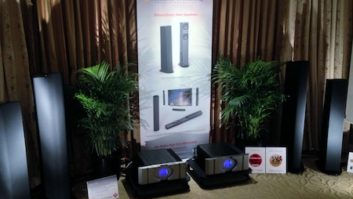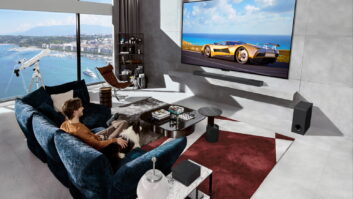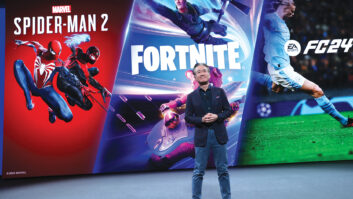I entered this CES more interested in OLED than any other video technology. More than 4K. Certainly more than 3D. Today’s time spent on the show floor has pretty much disabused me of my impatient fascination with the troubled-but-stunning-looking technology, though.
More on that in a moment.
Before I made my way to the show floor at the Las Vegas Convention Center this morning, the day kicked off with breakfast at the Embassy Suites, thanks to HiFiMan. Founder Dr. Fang Bian gave the packed room a rundown of the company’s new products, including new in-ear headphones (the first of a completely revamped line), as well as the HM-901, the company’s new hi-fidelity portable music player, which is leaps and bounds above previous efforts in terms of interface and navigation. What’s really neat about the HM-901 is that it features a modular amplifier design, so you can pop out the stock amp and add optional ones better suited to different impedances and sensitivity in headphones. Bian also put the DAC in the HM-901 up against a $2000 standalone NAD DAC in an A-B-A test, without telling us which was A and which was B at first. The interesting thing is that there were quite diverse opinions about which sounded better—and they definitely sounded a little different, that’s for sure—but there was no clear winner once I tallied the votes in an informal poll on the walk back to the LVCC.

The first stop there was at the HDBaseT Alliance, where we got a rundown of new ways the technology is being implemented to deliver HDMI, power, Ethernet, and control signals, as well as the newer HDBaseT Lite spec, which covers shorter runs and loses the Ethernet capabilities, but also costs quite a bit less.
The next logical stop was WyreStorm, whose AMP-001-010 Amplifier, combined with the company’s HDBaseT matrix switches, really takes HDBT technology to a new level, by adding local 2.1-channel audio with amplification. Talking about all of the ways this system could be implemented would be a book in and of itself, not just an article, but to scratch the surface: you can use it to extend an HDMI signal over Cat-5e/6 up to 70 meters, route the video to a display at the end of that run, and hook up speakers directly to the amp, without having to use an AV receiver. Add in the company’s 8×8 matrix, and you could do a 56-display system, with IR or RS-232 control, not to mention audio return channel from the displays. Neat stuff, and it solves so many problems and can be configured so many ways that I can see it cutting way down on the inventory of products installers need to keep in the shop to do everything from complicated multi-room distributed AV to simple, discrete one-display systems.

WyreStorm’s AMP-001-010 Amplifier, combined with the company’s HDBaseT matrix switches adds local 2.1-channel audio with amplification.
After that, my day overlapped quite a bit with Sciacca’s, so be sure to check out his report, but we parted ways in the afternoon, which is when my obsession with OLED died. The thing is, my passion for that tech always has been driven by video quality—the better blacks, the awesome brightness, the eye-popping color, and the clarity of the image. The thing is, though, in the years that we’ve been waiting for OLED to become an actual thing, plasma snuck up and nipped its heels in all of those aspects. Panasonic’s ZT60-series plasmas are being hailed as the best display of the show by many of my colleagues, and deservedly so. The blacks are nigh perfect. Brightness is approaching LED/LCD levels. Colors are just startlingly good.

Really, you could have hidden the signage in front of the display and convinced me it was OLED.
I also popped by Samsung’s booth to check out the new 8 Series plasmas, and if they’re not just as good as the Panasonic ZT60s, they’re really stinkin’ close. I suspect that many of my colleagues are giving Panny the nod because the demo material in that booth is more dynamic, with starker contrasts and more Crayola colors. What I would love to do is put them side-by-side running the same demo reel (preferably Panasonic’s) and see if either comes out on top.

Either way, both sets are so ridiculously good, I’m just giving up on waiting for LG, Samsung, and Sony to get an actual OLED to the market.
In Samsung’s booth, I also checked out the new SmartHub, which is another huge improvement over last year’s smart TV package. I also got a look at the Evolution Kit, which upgrades the GPU and CPU of 2012 Samsung Smart TVs to 2013 specs, and completely upgrades the UI—and the remote!—to match this year’s.

Samsung’s SmartHub.
Speaking of the remote, though, there’s one aspect of the new SmartHub that appeals to my CE side, but gives my CI side a sad face. Apparently, Samsung intends for you to use their remote and their remote only to access a feature that takes control of your set-top cable or satellite box, and makes smart recommendations about upcoming shows you’ll probably want to check out, based on what you’ve watched at that time of day before. An IR connection on the back of the TV connects via a repeater to the set-top box, so Samsung expects you to ditch your provider’s remote and use theirs. What about those of us with advanced control systems, though? Well, Samsung representatives told me that if you want to get the most of that feature of the displays, you’ll probably want to use your automation remote for source switching and stuff, but keep the Samsung remote handy for channel surfing and voice control.
I sort of wanted to get grumpy about this, but to be honest, as I was making my way out of the booth and spotted the 8 Series plasma again, and all was forgiven.
Seriously, OLED, you’re not just on notice; you’re dead to me now.
Dennis Burger has been reviewing and writing about consumer electronics since 1999. He and his wife live in Montgomery, Alabama.







